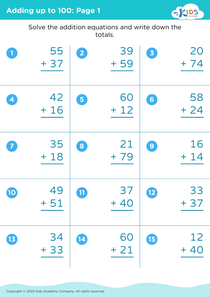Visual interpretation Adding up to 1000 Worksheets for Ages 7-9
3 filtered results
-
From - To
Discover our engaging "Visual Interpretation Adding Up to 1000 Worksheets" designed for children aged 7-9! This collection helps young learners master addition techniques through visual aids and creative challenges. Each worksheet encourages students to visualize numerical relationships and practice problem-solving with attractive graphics and interactive formats. By using diverse scenarios, children will enhance their understanding of addition while developing critical thinking skills. Perfect for reinforcing math concepts at home or in the classroom, these worksheets make learning fun and effective. Explore our extensive resources and support your child's mathematical journey today!
Visual interpretation is a crucial skill for children aged 7-9, impacting their overall learning and development. At this age, children are not only absorbing information but also learning to analyze and interpret what they see. By strengthening their ability to interpret visual data—like graphs, charts, maps, and illustrations—parents and teachers help children make connections between different concepts.
For instance, visual aids can enhance comprehension in subjects such as mathematics, where understanding shapes or fractions can be facilitated by visual representations. This skill also translates to reading, as children learn to extract meaning from picture books or illustrations accompanying texts.
Moreover, visual literacy fosters critical thinking. When children learn to assess images critically, they develop discernment and become more adept at questioning and investigating. This is essential in a world filled with information, where not everything presented visually is accurate or truthful.
Encouraging exploration of visual materials also promotes creativity, as children express their understanding through drawings, diagrams, and other forms of visuals. By prioritizing visual interpretation, parents and teachers empower children to navigate their school years more effectively and build a strong foundation for future learning in an increasingly visual world.















